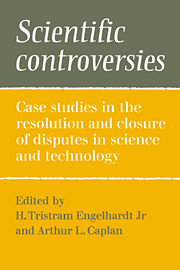 Scientific Controversies
Scientific Controversies Book contents
- Frontmatter
- Contents
- Preface
- List of contributors
- Introduction: Patterns of controversy and closure: the interplay of knowledge, values, and political forces
- PART I THEORETICAL PERSPECTIVES
- PART II CONTEMPORARY CASE STUDIES
- PART III CONTROVERSY, CLOSURE, AND THE PUBLIC
- 26 The role of the mass media in scientific controversy
- 27 The National Commission on Human Experimentation: procedures and outcomes
- 28 The forms and norms of closure
- Author index
- Subject index
27 - The National Commission on Human Experimentation: procedures and outcomes
Published online by Cambridge University Press: 03 February 2010
- Frontmatter
- Contents
- Preface
- List of contributors
- Introduction: Patterns of controversy and closure: the interplay of knowledge, values, and political forces
- PART I THEORETICAL PERSPECTIVES
- PART II CONTEMPORARY CASE STUDIES
- PART III CONTROVERSY, CLOSURE, AND THE PUBLIC
- 26 The role of the mass media in scientific controversy
- 27 The National Commission on Human Experimentation: procedures and outcomes
- 28 The forms and norms of closure
- Author index
- Subject index
Summary
The National Commission for the Protection of Human Subjects of Biomedical and Behavioral Research (the “National Commission,” for short) was set up in 1974 by the U.S. Congress as one of the provisions of the National Research Act, P.L. 93–348, and its members were sworn in during December of that year. The primary part of the commission's formal agenda comprised a series of questions about the ethical requirements to be insisted on as conditions for the federal funding of research projects involving human subjects who were recognized as belonging to certain especially vulnerable groups. (Three or four other more or less peripheral items were added to this primary agenda, but I shall not discuss them here.)
Because the public controversies that preceded the establishment of the National Commission, in the aftermath of the U.S. Supreme Court's abortion decision, had been excited by horrifying press reports about scientific experiments on human fetuses, that was the group of vulnerable research subjects whose protection the National Commission was instructed to consider first, and a four-month moratorium was imposed on federal funding of fetal experiments while the commission dealt with this first task. Subsequent groups of vulnerable subjects consisted of young children, prisoners, and “the institutionalized mentally infirm,” to cite the idiosyncratic language of the Act. Incidentally, the National Commission was also instructed to report on the ethical requirements relevant to the performance of psychosurgery. The reasons for this addition were evidently political.
- Type
- Chapter
- Information
- Scientific ControversiesCase Studies in the Resolution and Closure of Disputes in Science and Technology, pp. 599 - 614Publisher: Cambridge University PressPrint publication year: 1987
- 22
- Cited by


